
And Depression glass, occupied Japan dishes, Nippon, fiestaware, fireking, cremex, etc. etc. etc.
There's so much out there, and I know so LITTLE about it, but I am going to try to put some interesting information on here for beginners, as I obtain it. In the meantime, I'll show my few little pieces here, and what I've learned about it.
Soon I plan to add an extra page with some of the information from my glass books telling the history of carnival and depression glass. This page last updated December 24, 1997.
This is the link to the wonderful carnival glass club page I belong to; they are a really big help in identifying and pricing glass. You should take a look at their auction; beautiful stuff!
You should see my Christmas present: a Fenton Dragon and Lotus flat bowl-beautiful! Very soon its picture will be here, along with a complete set of photos of my son's bottle collection.
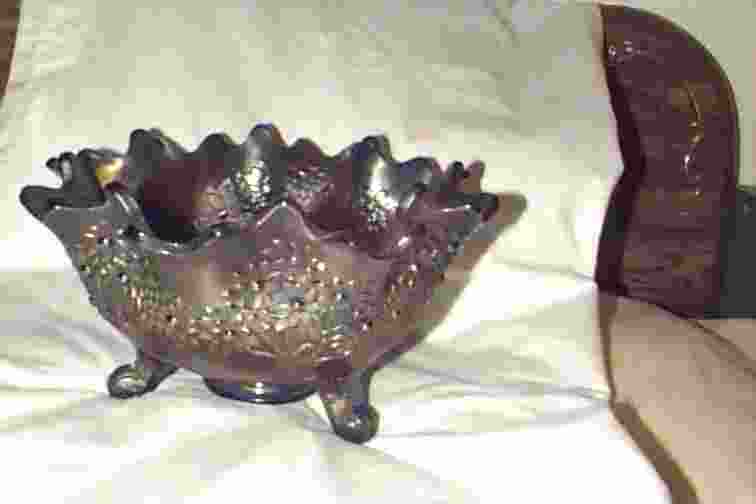 |
This bowl is carnival glass, 8.5" across, with the Orange Tree pattern inside and out, 3 feet on bottom, royal blue with nice iridescence. Fenton can't really tell me what to call it; they called it the "master berry bowl" but it doesnt slightly resemble the berry bowl. It looks like an exact but smaller version of their large orange bowl. Im told it's circa 1911-1915 (we've had it since 1935) and the value is about $140. I'm told Fenton made a LOT of pieces in this pattern. |
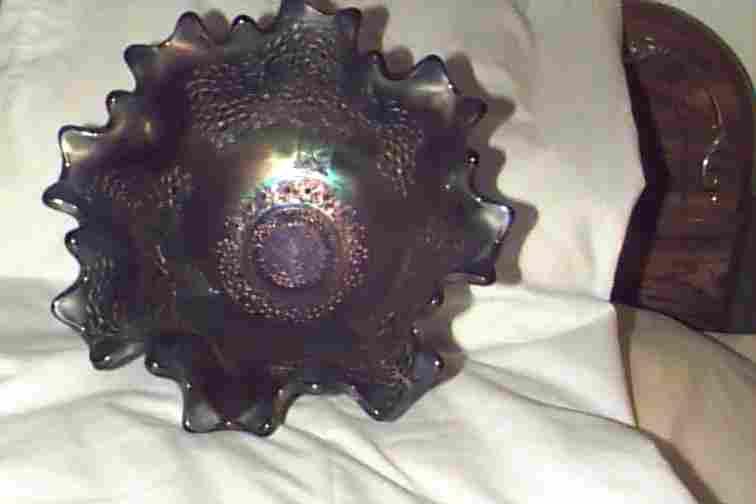 |
The inside has orange trees on the sides and this little circle of flowers in the bottom. The iridescence is in good shape but for a few pinpricks and small scratches in the bottom, that's because my family kept things in it for a long time. Now if only someone would tell me how to wash off 60 years worth of cigarette smoke without damaging the iridescence. Carnival glass is said to be ALL iridescent, but I have seen some in the books that is actually clear. |
 |
More carnival glass, but brand new! I couldnt resist it at an antique shop sale in Redlands, It is the Fenton swan vase in plum carnival. The iridescence is gorgeous. The Fenton man told me they used a mold from the late 1930's-1940, but I can't find the pattern in their book. They have discontinued making it for now, but possibly may make more later, not a limited edition. About7-8" tall. However, the docent at the Redlands Glass Museum tells me ALL carnival glass is now collectible! |
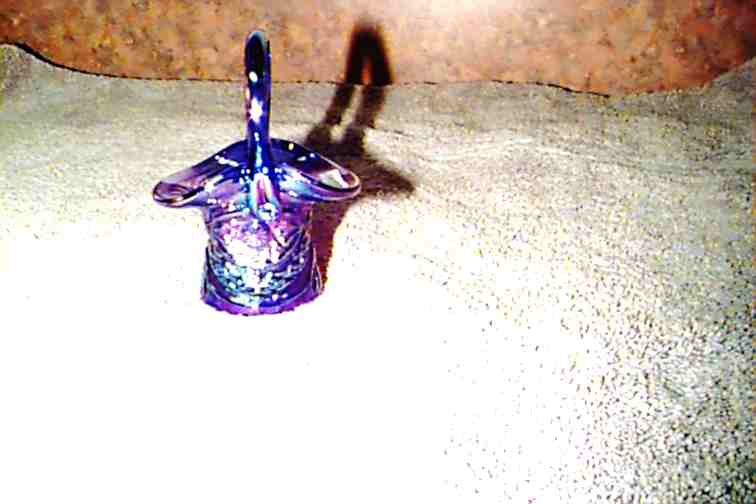 |
More new carnival glass, bought at the Redlands Glass Museum, a tiny basket in blue carnival by the Gibson Company, a contemporary company. Thought it would make a nice Christmas gift for a young person who can hold it 'till it has increased in value. |
 |
This butterfly was made by the Westmoreland Co. (they made a lot of old glass, closed their doors in 1985) as a LIMITED edition made especially for the Redlands Glass Museum. It comes with a little brass stand. They were made in 1977 so they are already 20 years old. Still has the sticker on it. This one may be worth a little more because it has a production defect; look at the edge of the left wing; the design is blurred. |
 |
These are marigold colored carnival glass items, or so I am told; there is a commemorative plate, not very iridescent. The two candy dishes or ashtrays (?) are plain on the inside; all the carving or embossing is on the outside, as you can see on the one turned upside down. It might be bearded berry, or maybe just junk. |
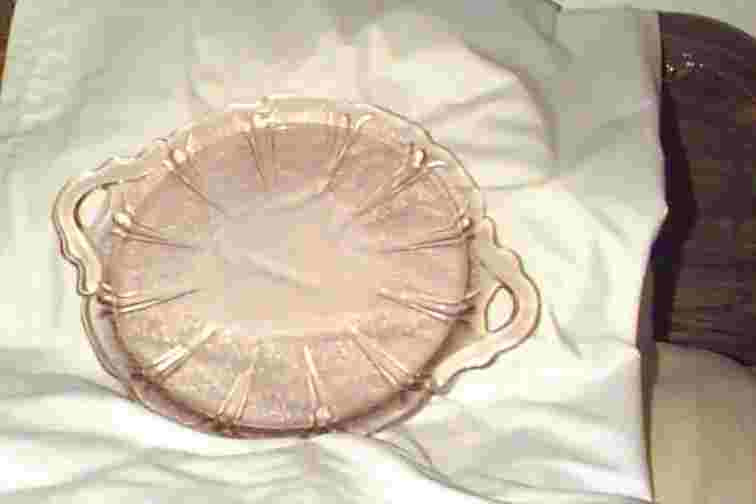 |
This is depression glass, an open handled tray in the pink cherry blossom pattern, made by the Jeannette Glass Company in the 30's; only worth about $25, but very pretty. Hard to show the color here, I'm not much of a photographer. Most depression glass patterns come in several colors, a lot of them in pink and green. Depression glass was mostly clear, but some pieces were opaque, and one pattern (Floragold) looks a little bit iridescent. Pieces of this glass were given away at movie matinees, in cereal boxes, in flour sacks, etc., in the 1930's. Carnival glass was made by art glass producers earlier, from about 1905 - 1921. |
 |
This knobby bowl is a little bit opalescent, looks just like the "Moonstone" pattern depression glass; it was in my mother's things so could be old. But I havent seen this shape bowl in the moonstone. Ditto this little clear bowl;it was with the depression glass, but it may be new for all I know. It has a swirl pattern and is very shiny. I cant find it in any of my books. But it is beautiful. |
 |
This is a depression glass pink cake plate in the Mayfair Open Rose Pattern. It has three long thin pieces on the bottom to elevate it, guess you could call them feet. A little chip off one foot is all the damage I can find. Worth about $35. It's the light pink color,which doesn't show up too well here. |
 |
This is just a little plain glass tray, large enough to hold a sugar and creamer, in the light pink depression color, with no pattern on it at all. I don't know what it held, but it was with the depression glass. I need to redo it; the color doesn't show here. |
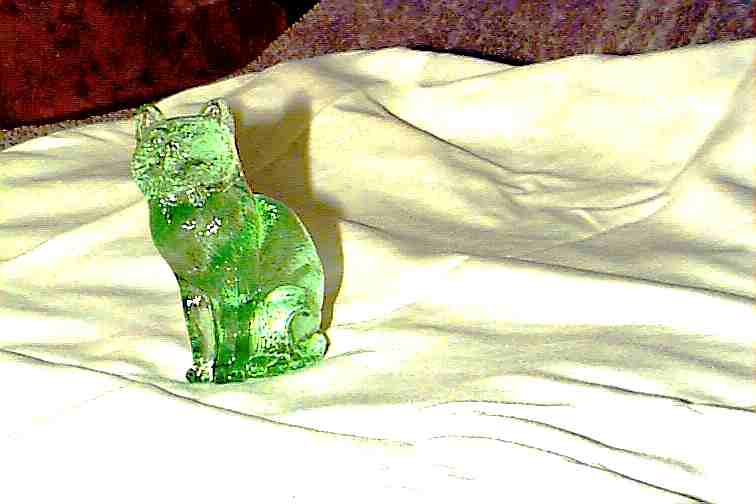 |
This is a little clear green kitty, 2.5 to 3" tall, I'm told made by Fenton but have no proof. He was inexpensive, can't be REAL old; might be 20-30 years old. But he's pretty and he's a kitty in good physical shape, no chips. |
 |
This is a gorgeous handpainted kitty, new, made by Fenton and signed by the artist on the bottom, about 3" tall. |
 |
This is the Fenton misty blue kitty, new, I don't think it's a limited edition, but still has the Fenton sticker. No painting on it, but nice iridescence. About 3" tall. |
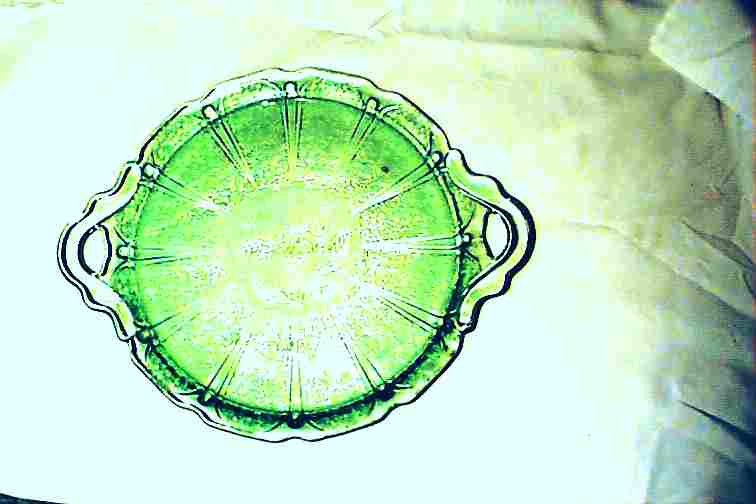 |
This matches the open handled tray above in pink, except it's in green, from Jeannette Co., 1930's. This one's in perfect condition except for a few scratches on the top. Im told the reproduction of this item shows as follows: Hold the tray with a handle at the top (north) and the center large cherry sprig should face east and west while the rayed designs face north and south. It's a light green, much lighter than it looks here. Worth about $28-$33. |
 |
Approximately 4" high footed tumblers, same light green cherry blossom as above. Sorry they are much lighter than the picture. I'm told the old ones have 2 or 3 thin lines around the top inside, while new ones have only one thick line. These have a very thin double line. Price range $14-$20 each. |
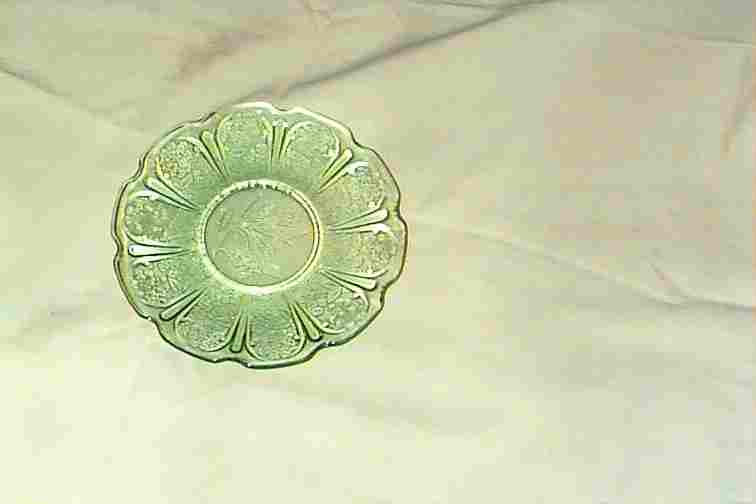 |
OK, HERE WE GO with the right color! This is almost perfect, just a little light. Same color, pattern as above, only in a saucer. Price range $4-$5 each. If it's a reproduction the mold line may be offset or shallow and the center of the leaf has a canal line. |
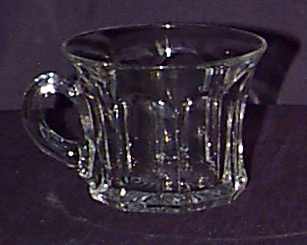 |
This is my Heisey cup; Heisey made what was called "Depression Era" glass; it was made at the same time as depression glass, but was more expensive glass. Heisey didn't make the free "give away" glass. This cup is small, maybe meant for tea. Don't know the pattern yet. |
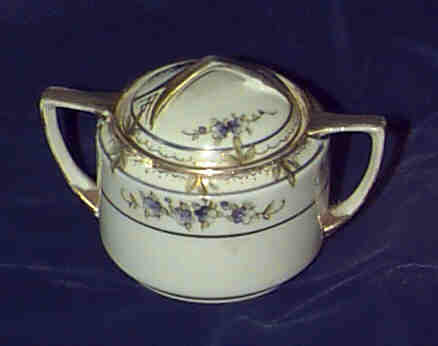 |
This is my Nippon sugar bowl. Nippon was made from the 1880's to the 1920's; it was the stamp they used before they started using "Japan", then later "made in Japan". This is handpainted. |
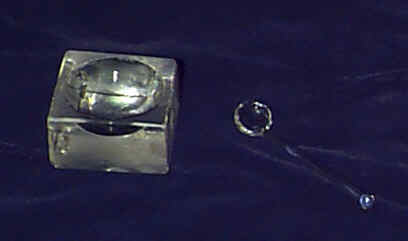 |
This is a salt cellar purchased at the Glass Museum in Redlands, California; made in the early 1800's. The spoon was a later addition, age unknown. Has a couple of big chips. |
History and Facts Regarding Depression/Carnival Glass
Depression Glass: It was produced in the 1920's and 1930's. It was machine made, mass produced colored transparent inexpensive glassware. It was made by a tank molding process. Variations were made by using different mold methods: Mold-etched, paste-mold, cut-mold, and chipped-mold. At the same time, better glass companies were making a better quality of glass, called "depression era" glass; notable companies were Heisey and Fostoria. But back to depression glass. It was given away; sometimes in the movies, just before the matinee. People collected entire sets this way. Some of it came in cereal boxes; some in sacks of flour, some in soap flakes (mainly tumblers here). Even when you had to buy it, it was inexpensive. You could buy a complete luncheon set for $1.99. Collectors started calling it "depression glass" in the 70's. Later I will be scanning in some pattern drawings and names for your information. There have been reproductions since the 30's, and these later pieces are not worth much but many of the pieces were not reproduced. In some of the patterns only a few pieces have been reproduced. If you have a good "Collector's Encyclopedia of Depression Glass", it will list the reproductions and how to recognize them. We will be showcasing them at a later time. Some of the pieces are very rare and valuable because they tended to break easily and there are not many left, such as the pink cherry blossom salt and pepper shakers; only two sets have been found and they are worth $1,200 each. There may be some in your grandmother's attic! Interesting fact: The Fenton Company produced a plain glassware set with 44 pieces, including a decanter, icebucket and various sized glasses in plain glass (a tumbler set) to celebrate the end of prohibition; it was called the "repeal set"; these would be a real find.
Carnival Glass: A completely different category from depression glass. Beginning in the 1880's, many glass companies produced "art glass"; handblown pieces or molded hand decorated pieces that were much too expensive for the ordinary person to purchase. Then in the 1900's, in about 1905, they began to produce molded pieces which they then fired with metal salts to produce an iridescent finish. They were beautiful, mainly gaudy, pieces that had great appeal for the public, and were very popular for about 15 years, very inexpensive. I've heard it was sometimes called "baking powder glass" and was given away in bags of baking powder. Later we will list patterns and companies for you; some of the main companies were Fenton (still in business), Dugan, Millersburg, Imperial, and Northwood. These pieces were not as expensive as the original art glass pieces and were very popular in every household. They came in beautiful iridescent colors; mainly marigold, cobalt blue or royal blue, amethyst, and green. By 1920 the pieces had become unpopular and some were even used in carnival booths as prizes; thence the name "carnival glass". Today they are rare items and prized by collectors. We will list patterns and prices as soon as possible.
